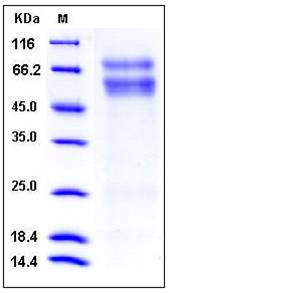Mouse CHST3 / C6ST-1 Protein (His Tag)
C6ST,C6ST-1,GST-0
- 100ug (NPP3261) Please inquiry
| Catalog Number | P50577-M07H |
|---|---|
| Organism Species | Mouse |
| Host | Human Cells |
| Synonyms | C6ST,C6ST-1,GST-0 |
| Molecular Weight | The recombinant mouse CHST3 comprises 453 amino acids and predicts a molecular mass of 52 kDa. As a result of glycosylation, the apparent molecular mass of mouse CHST3 is approximately 55-75 kDa in SDS-PAGE under reducing conditions. |
| predicted N | His |
| SDS-PAGE |  |
| Purity | > 95 % as determined by SDS-PAGE |
| Protein Construction | A DNA sequence encoding the extracellular domain of mouse CHST3 (NP_058083.2) (Glu 39-Thr 472) was fused with a polyhistidine tag at the N-terminus. |
| Bio-activity | |
| Research Area | Cardiovascular |Angiogenesis |Adhesion Molecules in Angiogenesis |Extracellular Matrix |ECM Proteins |Glucosaminoglycans | |
| Formulation | Lyophilized from sterile PBS, pH 7.4 1. Normally 5 % - 8 % trehalose, mannitol and 0.01% Tween80 are added as protectants before lyophilization. Specific concentrations are included in the hardcopy of COA. |
| Background | Mouse carbohydrate sulfotransferase 3, also known as Chondroitin 6-O-sulfotransferase 1, Chondroitin 6-sulfotransferase and CHST3, is a single-pass type I I membrane protein which belongs to the sulfotransferase 1 family and Gal / GlcNAc / GalNAc subfamily. CHST3 is widely expressed in adult tissues. It is expressed in heart, placenta, skeletal muscle and pancreas. CHST3 is also expressed in various immune tissues such as spleen, lymph node, thymus and appendix. CHST3 catalyzes the transfer of sulfate to position 6 of the N-acetylgalactosamine (GalNAc) residue of chondroitin. It is a chondroitin sulfate which constitutes the predominant proteoglycan present in cartilage and is distributed on the surfaces of many cells and extracellular matrices. It can also sulfate Gal residues of keratan sulfate, another glycosaminoglycan, and the Gal residues in sialyl N-acetyllactosamine (sialyl LacNAc) oligosaccharides. It may play a role in the maintenance of naive T-lymphocytes in the spleen. Defects in CHST3 are the cause of spondyloepiphyseal dysplasia Omani type (SED Omani type) which is an autosomal recessive disorder characterized by normal length at birth but severely reduced adult height (110-130 cm), severe progressive kyphoscoliosis, arthritic changes with joint dislocations, genu valgum, cubitus valgus, mild brachydactyly, camptodactyly, microdontia and normal intelligence. As a consequence of the arthropathy and the contractures, affected individuals develop restricted joint movement. Defects in CHST3 are also a cause of humerospinal dysostosis (HSD) which is characterized by bifurcation of the ends of the humerus, subluxation in the elbow joints, widened iliac bones, talipes equinovarus and coronal cleft vertebrae. Congenital, progressive heart disease, possibly with fatal outcome, is observed in some patients. |
| Reference |
